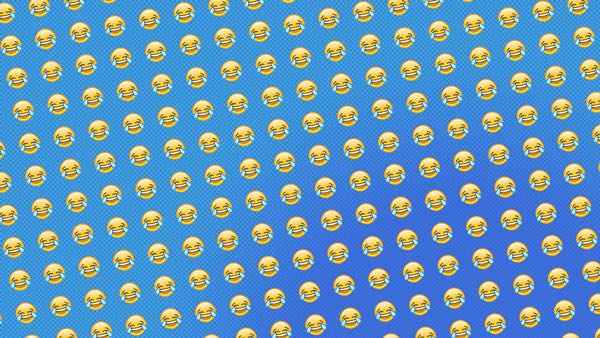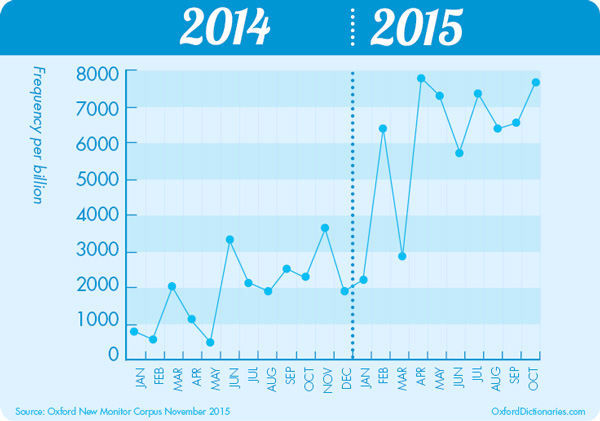Words have officially failed us: Oxford Dictionaries Word of the Year is an emoji

The Oxford Dictionaries Word of the Year is an emoji.
Not the word emoji. An actual one. Specifically, the "Face with Tears of Joy".

If you own a smartphone, you've seen it. If you're on any Whatsapp group that sends or receives forwards, you've seen it.
Because this 'word', according to the Oxford Dictionaries, "best reflects the ethos, mood and pre-occupations of 2015".
We wish it meant that this year we've all been laughing collective joyous tears. What a picturesque Lennon year that would have been.
Instead, what it really means is that we've been sending out emojis a lot. This particular one above all others.
20% of all emojis used in the UK this year was this one. The figure is 17% in the US. It's also the most used emoji worldwide.
Hell, Hillary Clinton sent out a tweet asking students to tell her how they feel about student debt - in 3 emojis or less.
But why would Oxford Dictionaries, keeper of words, Bible of linguists and Spelling Bee champions, relinquish the power of the word to a pictograph?
The answer may lie in a little emoji story
In 2009 a data engineer, Fred Benenson, began a Kickstarter Campaign to translate the entire Moby Dick into a series of emojis.
The campaign succeeded.
Benenson contracted thousands of people to translate one sentence of the novel each. This was then compiled into a book and acquired by the Library of Congress in the United States. That's right. There now exists a bound adaptation of Herman Melville's classic called Emoji Dick.
And while it seems a bizarre enough phenomenon for us to call out, Oxford Dictionaries is clearly seeing the writing on the wall: literature and all writing, not just smartphone writing, will soon be emojified.
Here's another example: sometime last month, I encountered a Buzzfeed story by Rega Jha about accents.
While explaining the problems of cross-cultural accents, she uses an emoticon to explain herself.

A paragraph or two of lucid prose explaining that our manner of speech need not necessarily be linked with the cultures we come from would have done the job just as well.
But this ^ is simply. too. easy. And if sparser language is how we're increasingly choosing to communicate, as Buzzfeed listicles routinely prove, then this choice starts to make perfect sense.
Clearly, it did to the folks at Oxford Dictionary.
With this choice, Oxford Dictionaries has ensured they'll be at the helm of change, Oxford flag high in the air, when the first e-book with animated emoticons hits the Kindle. Because judging by the meteoric rise of the emoji, it's no longer an if. It's a question of when.
(Not convinced? There's also the Narratives in Emojis and the Emoji Art history to change your mind.)
It began with Heart
The word emoji has been around since 1997. And like the best kinds of massages and Kitkat, emojis came from Japan.
In 1995, when pagers were all the rage among teenagers in Japan, Docomo created the heart emoji. (The word moji means letter or character in Japanese).
The heart emoji was a success, but Docomo wanted to leave behind the teenybopper market, and venture into more business-friendly features like Latin alphabet support and kanji.
When that backfired (just as it did with the Blackberry) they decided to expand the number of emojis available. And Shigetaka Kurita, an engineer at Docomo, was given the job of designing a complete set of 176 emojis, 12 pixels by 12 pixels, to cover the entire breadth of human conversation.
Though a success, Docomo's emojis worked only on Docomo phones. Which meant competitors had no choice but to create a parallel set of characters. And when texts were exchanged across devices, users saw. a whole lot of garbled nothing.
Enter the Unicode consortium.
The Unicode Standard, which writes code for displaying characters like letters, math symbols and Chinese pictograms, ensures that messages read the same across devices. They created a standard for emojis, available for any device that adopts a Unicode keyboard.
That process began in 2007. More and more emojis got added to the Unicode standard till 2010 (and continues to).
And then in 2011, the emoji world exploded
It happened, as these things often do, with Apple - masters not of invention as much as appropriation.
In 2011 the tech giant added a Unicode emoji keyboard to iOS5, taking it global.
And the use of the emoji - both the pictograph and the word, has doubled and quadrupled - not year on year - but month on month since.

To see how the body language of telecommunications has evolved since 1997, read here.

•More in Catch:
Derp: the internet slang that's good enough for NYT but not for Gawker
Lit Feast: this woman wants to change how words get added to dictionaries
Manspreading & butt-dial: Oxford dictionary's new words are awesomesauce







![BJP's Kapil Mishra recreates Shankar Mahadevan’s ‘Breathless’ song to highlight Delhi pollution [WATCH] BJP's Kapil Mishra recreates Shankar Mahadevan’s ‘Breathless’ song to highlight Delhi pollution [WATCH]](https://images.catchnews.com/upload/2022/11/03/kapil-mishra_240884_300x172.png)

![Anupam Kher shares pictures of his toned body on 67th birthday [MUST SEE] Anupam Kher shares pictures of his toned body on 67th birthday [MUST SEE]](https://images.catchnews.com/upload/2022/03/07/Anupam_kher_231145_300x172.jpg)






